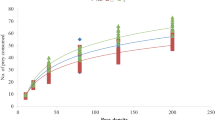Abstract
The number of encounters per prey, the proportion of encounters resulting in attacks, and the proportion of attacks that were successful were observed while fourth-instar Notonecta undulata nymphs preyed on smaller N. undulata nymphs. While encounters per prey and proportion of encounters resulting in attacks increased with prey size, the proportion of attacks that were successful decreased. The increase in encounter rate per prey was due in part to an increase in the predator's reactive distance to prey as prey size increased. While none of the attack parameters varied significantly with prey density, logarithmic regression of the number of encounters per unit search time on prey density suggested that prey density tends to have a positive effect on encounters per first-instar prey but a negative effect on encounters per second-instar prey. A functional response model is presented that incorporates components of the predator's attack rate as exponential functions of prey density and allows for effects of the time the predator may spend evaluating prey encountered but not attacked and time spent attacking prey not captured. Estimates of the attack parameters derived from the experimental data are used in the model to generate functional response curves for fourth-instar N. undulata preying on first- or second-instar conspecifics. The predicted curve for second-instar prey is typical type II but the curve for firstinstar prey is slightly positively density dependent at low prey densities, i.e., type III.
Similar content being viewed by others
References
Abrams PA (1990) The effects of adaptive behavior on the type-2 functional response. Ecology 71: 877–885
Akre BG, Johnson DM (1979) Switching and sigmoid functional response curves by damselfly naiads with alternative prey available. J Anim Ecol 48: 703–720
Bailey PCE (1986a) The feeding behaviour of a sit-and-wait predator, Ranatra dispar, (Heteroptera: Nepidae): description of behavioural components of prey capture, and the effect of food deprivation on predator arousal and capture dynamics. Behaviour 97: 66–93
Bailey PCE (1986b) The feeding behaviour of a sit-and-wait predator Ranatra dispar (Heteroptera: Nepidae): the effect of prey density and age structure on the number of prey eaten. Ethology 72: 277–286
Bailey PCE (1986c) The feeding behaviour of a sit-and-wait predator, Ranatra dispar (Heteroptera: Nepidae): the combined effect of food deprivation and prey size on the behavioural components of prey capture. Ethology 71: 315–332
Beukema JJ (1968) Predation by the three-spined stickleback (Gasteposteus aculeatus L.): the influence of hunger and experience. Behaviour 31: 1–126
Eggleston DB (1990a) Foraging behavior of the blue crab, Callinectes sapidus, on juvenile oysters, Crassostrea virginica: effects of prey density and size. Bull Mar Sci 46: 62–82
Eggleston DB (1990b) Functional responses of blue crabs Callinectes sapidus Rathbun feeding on juvenile oysters Crassostrea virginica (Gmelin): effects of predator sex and size, and prey size. J Exp Mar Biol Ecol 143: 73–90
Fienberg SE (1980) The analysis of cross-classified categorical data, 2nd edn. MIT Press, Cambridge
Fox LR, Murdoch WW (1978) Effects of feeding history on shortterm and long-term functional responses in Notonecta hoffmanni. J Anim Ecol 47: 945–960
Gendron RP, Staddon JER (1983) Searching for cryptic prey: the effect of search rate. Am Nat 121: 172–186
Getty T (1985) Discriminability and the sigmoid functional response: how optimal foragers could stabilize model-mimic complexes. Am Nat 125: 239–256
Getty T, Pulliam HR (1991) Random prey detection with pause-travel search. Am Nat 138: 1459–1477
Giller PS (1980) The control of handling time and its effects on the foraging strategy of a heteropteran predator, Notonecta. J Anim Ecol 49: 699–712
Giller PS, McNeill S (1981) Predation strategies, resource partitioning and habitat selection in Notonecta (Hemiptera/Heteroptera). J Anim Ecol 50: 789–808
Gittelman SH (1978) Optimum diet and body size in backswimmers (Heteroptera: Notonectidae, Pleidae). Ann Entomol Soc Am 71: 737–747
Hassell MR (1978) The dynamics of arthropod predator-prey systems. Princeton University Press, Princeton
Hassell MP, Lawton JH, Beddington JR (1976) The components of arthropod predation, I. The prey death-rate. J Anim Ecol 45: 135–164
Hassell MP, Lawton JH, Beddington JR (1977) Sigmoid functional responses by invertebrate predators and parasitoids. J Anim Ecol 46: 249–262
Hewett SW (1988) Predation by Didinium nasutum: the effects of predator and prey size. Ecology 69: 135–145
Holling CS (1959) Some characteristics of simple types of predation and parasitism. Can Entomol 91: 385–398
Holling CS (1966) The functional response of invertebrate predators to prey density. Mem Entomol Soc Can 48: 1–86
Hughes RN (1979) Optimal diets under the energy maximization premise: the effects of recognition time and learning. Am Nat 113: 209–221
Lipcius RN, Hines AH (1986) Variable functional responses of a marine predator in dissimiliar homogeneous microhabitats. Ecology 76: 1361–1371
McArdle BH, Lawton JH (1979) Effects of prey-size and predator-instar on the predation of Daphnia by Notonecta. Ecol Entomol 4: 267–275
Nelmes AJ (1974) Evaluation of the feeding behaviour of Prionchulus punctatus (Cobb), a nematode predator. J Anim Ecol 43: 553–565
Pastorok RA (1981) Prey vulnerability and size selection by Chaoborus larvae. Ecology 62: 1311–1324
Reynolds JG, Geddes MC (1984) Functional response analysis of size-selective predation by the notonectid predator Anisops deanei (Brooks) on Daphnia thompsoni (Sars). Aus J Mar Freshwater Res 35: 725–733
Rogers D (1972) Random search and insect population models. J Anim Ecol 41: 369–383
Scott MA, Murdoch WW (1983) Selective predation by the back-swimmer, Notonecta. Limnol Oceanogr 28: 352–366
Spitze K (1985) Functional response of an ambush predator: Ghaoborus americanus predation on Daphnia pulex. Ecology 66: 938–949
Streams FA (1987) Foraging behavior in a notonectid assemblage. Am Midl Nat 117: 353–361
Streams FA (1992) Intrageneric predation by Notonecta (Hemiptera: Notonectidae) in the laboratory and in nature. Ann Entomol Soc Am 85: 265–273
Thompson DJ (1975) Towards a predator-prey model incorporating age-structure: the effects of predator and prey size on the predation of Daphnia magna by Ischnura elegans. J Anim Ecol 44: 907–916
Author information
Authors and Affiliations
Rights and permissions
About this article
Cite this article
Streams, F.A. Effect of prey size on attack components of the functional response by Notonecta undulata . Oecologia 98, 57–63 (1994). https://doi.org/10.1007/BF00326090
Received:
Accepted:
Issue Date:
DOI: https://doi.org/10.1007/BF00326090




